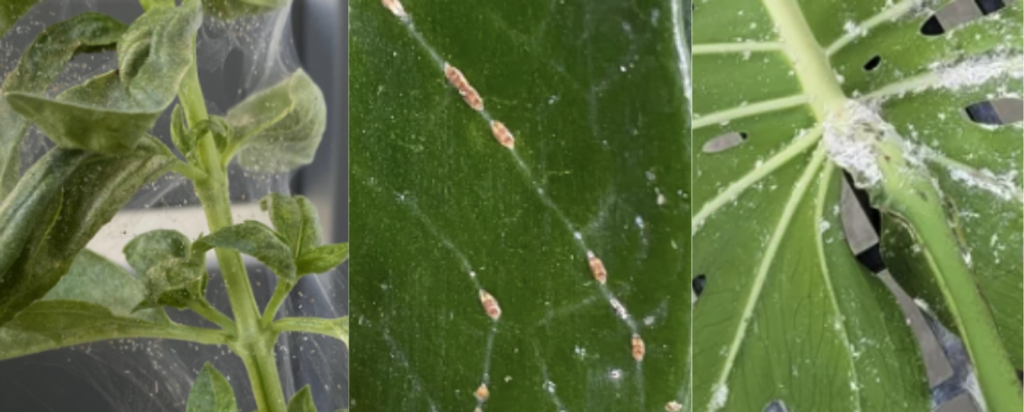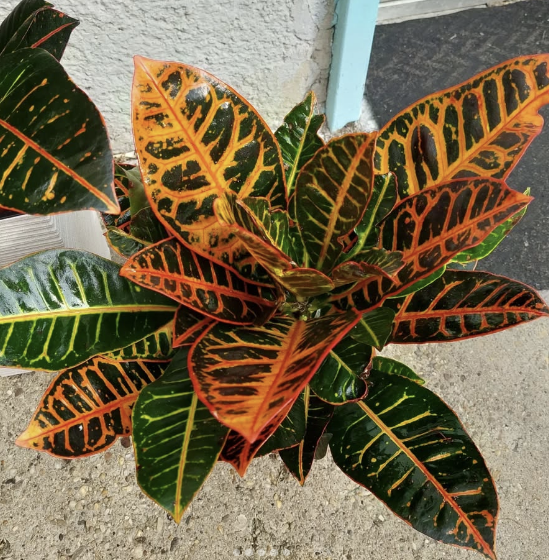The Mammy Croton plant is known for its unique, wavy leaves that grow upright and twist dramatically. These colorful leaves are thick and sturdy, with vibrant patterns of red, orange, yellow, and green. Its vivid colors make it a standout choice among other croton plants. It’s a smaller variety, typically growing up to 2-3 feet indoors and 3-4 feet outdoors, which makes it ideal for decorative pots, small trees, or even landscape crotons in warmer areas.
In their native habitat of tropical zones, these plants thrive as evergreen shrubs under bright sunlight in open forests. Their striking foliage and ability to grow in a variety of conditions have made them popular as both indoor plants and outdoor accents.
In this care guide, I’ll take you through everything you need to know to keep your Croton Mammy plant healthy and happy, from ideal lighting and watering schedules to dealing with common pests and issues.
Size
The Mammy Croton plant grows to about 2-3 feet in height when kept as an indoor plant. Outdoors, under the right conditions, it can reach 3-4 feet tall. Its compact size makes it perfect for tabletops, desks, or smaller garden beds. The plant grows slowly, so it doesn’t require frequent repotting, making it an excellent choice for people who want a colorful plant that doesn’t demand too much attention.
Care

Light Requirements
The Croton Mammy plant thrives in bright indirect light, which helps maintain its vibrant colors. Place it near a sunny window, but avoid full sun, especially during midday, as it can scorch the leaves. If your plant’s leaf color fades, it may not be getting enough light. It can tolerate partial shade, but its colors will be less intense. For outdoor plants, consider giving them afternoon shade in tropical zones or colder climates to protect them from extreme temperatures.
Water Requirements
Water your Croton Mammy when the top inch of soil feels dry. Use tepid water to avoid shocking the roots, and always check the soil moisture with your finger or a moisture meter. This plant prefers moist soil but dislikes soggy soil, which can lead to root rot. Make sure your pot has drainage holes to allow excess water to escape. During the winter months, reduce watering as the plant’s growth slows.
Signs of underwatering include wilting or drooping, while overwatering can cause yellow leaves, brown spots, or fungal issues like crown gall.
Temperature Needs
As a tropical plant, the Mammy Croton thrives in warm temperatures between 65-80°F (18-27°C). Avoid cold weather, drafts, and temperatures below 60°F (15°C). If growing outdoors, bring the plant indoors before the temperature dips too low to prevent stress and leaf drop.
Humidity
For best results, keep your plant in a humid environment with 40-60% humidity. Bathrooms or kitchens are great options. If your home is dry, especially in winter, consider using a pebble tray, a humidifier, or misting the leaves. However, avoid over-misting, which can encourage fungal diseases like crown gall. Regularly maintaining high humidity will also prevent issues like sparse leaves or dry edges on the foliage.
Soil
Use well-draining soil with organic matter for your Croton Mammy care. A mix of standard indoor potting soil with a bit of perlite or sand works well. This ensures proper aeration and prevents root rot caused by excess moisture. Adding slow-release fertilizer to the soil mix can also support new growth during the growing season.
Fertilizer
During the growing season (spring and summer), feed your plant every 4-6 weeks with a slow-release fertilizer or liquid fertilizer at half strength. Fertilizers rich in nitrogen and potassium are particularly beneficial for maintaining vibrant foliage. Avoid fertilizing during the winter months, as the plant’s life cycle slows down, and it doesn’t require additional nutrients.
Potting
Repot your Mammy Croton plant every 1-2 years in early spring or early summer if the root ball becomes crowded. Use a slightly larger pot with good drainage. These plants don’t mind being slightly root-bound, so only repot when necessary. Be gentle with the root system to avoid transplant shock. If you notice poor packaging when repotting or damaged roots, trim them before placing the plant in fresh soil.
Pruning
Pruning is not often needed, but you can trim off dead leaves or yellowing foliage to keep the plant tidy. If the plant becomes too tall or leggy, you can prune it back to maintain its shape. Use clean, sharp scissors or pruning shears. Removing parts of this plant that are damaged will encourage new leaves and healthier growth overall.
Propagation
The Croton Mammy plant can be propagated through stem cuttings:
- Take a 4-6 inch cutting from the parent plant during early spring or summer.
- Dip the cut end in rooting hormone (optional).
- Place the cutting in moist soil or water until new roots form.
- Keep the cutting in a warm, humid spot, and expect new growth in about 4-6 weeks.
Propagation is a great way to start a new plant for your plant collection or share with friends.
Pests
Here are some common pests that affect Croton Mammy plants and tips for dealing with them:
- Spider Mites: These pests thrive in dry conditions. Increase humidity and wipe leaves with neem oil or insecticidal soap.
- Scale Insects: Appear as small, brown bumps. Remove them with a cotton swab dipped in alcohol.
- Mealybugs: Look like white cotton clusters. Treat with neem oil or wipe away with a damp cloth.

Diseases
- Root Rot: Prevent this by avoiding overwatering and using well-draining soil.
- Leaf Spot: Caused by fungal infections due to excess moisture. Ensure good airflow and avoid misting directly on leaves.
- Crown Gall: A bacterial infection that causes swelling on stems. Prune away infected parts and disinfect tools after use.
Toxicity

Croton Mammy plants are considered toxic to pets and humans if ingested, so keep them out of reach of curious kids and pets. The sap can also irritate the skin, so it’s a good idea to wear gloves when handling or pruning the plant.
Common Issues and Solutions
- Leaf Drop: Can happen due to stress, drafts, or sudden changes in environment. Keep conditions consistent.
- Fading Colors: May indicate little light. Move the plant to a bright spot with bright indirect light.
- Wilting or Drooping: A sign of underwatering. Check the soil and water thoroughly if dry.
- Brown Spots: Could be caused by overwatering or tap water with high mineral content. Use filtered water if needed.
Difficulty Level
The Croton Mammy plant is moderately challenging to care for. It is sensitive to changes in light, temperature, and humidity, but once you provide the right conditions, it becomes a rewarding and low-maintenance house plant with vivid colors.
Have I Chosen the Right Croton Species?
Croton Mammy is just one variety among many colorful crotons. Some other popular types include Croton Petra, Croton Gold Dust, and Croton Magnificent, each with its own unique color pattern. If you’re new to crotons, Croton Mammy is a great choice for its manageable size and vibrant look.
Final Tips
To keep your Croton Mammy looking its best, give it plenty of light, regular watering, and a boost of humidity. It may take some time to adjust to its new home, but once it does, it will reward you with lush, colorful foliage that’s hard to beat.
Happy growing, and enjoy your beautiful Croton Mammy!

